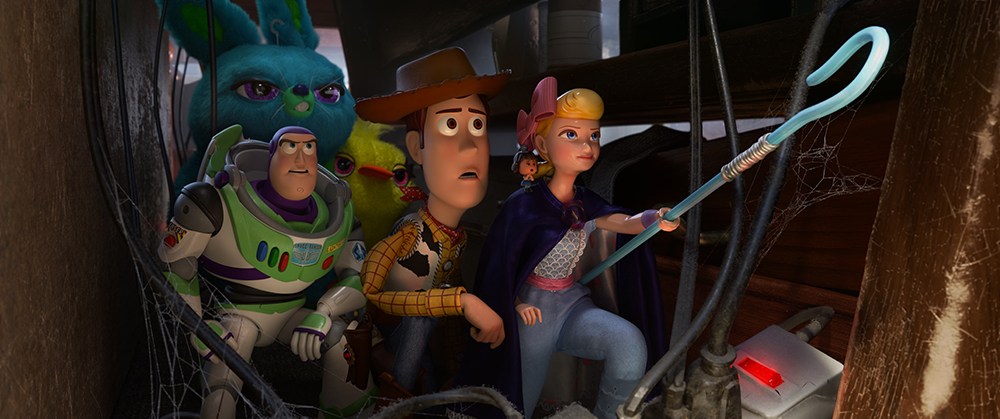Toy Story 4

(L-R) Tim Allen as Buzz Lightyear, Tom Hanks as Woody, and Christina Hendricks as Bo Peep in Pixar's TOY STORY 4.

Note: All reviews contain spoilers. Otherwise they’d be “previews”.
I once wrote of BACK TO THE FUTURE that its genius rested in telling a classic joke backwards. The TOY STORY franchise—covering the exploits of the affable sheriff, Woody (Tom Hanks) and his comically-masculine spaceman sidekick, Buzz Lightyear (Tim Allen)— tells the same joke backward, forward, sideways, up, down, and for a good part of the second act of the fourth installment, in a seemingly alternate dimension with a passing resemblance to the Overlook Hotel.
At the end of TOY STORY 3, a grown Andy (John Morris) discharges stewardship of his toys to another family’s preschooler, Bonnie Anderson (Madeline McGraw). At summer’s end and school’s start, the Andersons embark upon a road trip. But before they do, at kindergarten orientation, their creative daughter fashions a friend out of a spork and pipe wire cleaners, whom she names Forky—a salve for her first day jitters at school.
Once home, and alone with the other toys, Forky gains consciousness with a scream, and a question, “How am I alive?”
Aside from a garbage gag that my managing editor insists runs several beats too long—our annoyance becomes the joke—Forky acts as a philosophical and moral question mark. Once sentient, his intellectual curiosity blossoms as he slowly forms words, phrases, ideas. Yet he stops short when the writers need him to get with the program and focus on the plot. Perhaps there’s hope for a companion short film.
Back into the plot we go. Regulars Jessie (Joan Cusack), Mel (Mel Brooks), Rex (Wallace Shawn), Slinky (Blake Carter), and most of the other veteran players are each present. We know from the film’s opening that Bo Peep (Annie Potts) is likely to return. Bo is an excellent commentary on the changing times. When the series began in 1995, she wasn’t given much to do except hang on Woody’s arm. Since then, social movements striving for inclusiveness and representation pressed filmmakers to write previously marginalized characters conscientiously.
Surviving on her own at a roadside carnival for the past seven years, Bo becomes an action hero with agency and personality. She reconnects with Buzz and Woody to reclaim his wayward spork friend from an antique store menaced by a neglected doll named Gabby (Christina Hendricks) and her creepy henchmen who look like possessed clones of Edgar Bergen’s ventriloquist dummy. But, like many would-be villains in this series’ universe, Gabby too has a past with which we can empathize.
As Bo leads us through the adventure, she ditches the skirt. Staff in hand, with a glint in her eye, she evokes Charlton Heston and Harrison Ford, with touches of Bogart as well as Bacall. Negotiating their way through a seedy venue (inside The Claw, a vintage arcade game) they enlist the aid of Duke Caboom, Canada’s greatest stunt motorcyclist. Playing Caboom, Keanu Reeves does what he does best—being ostensibly Canadian and crashing motorcycles.
In spite of these newcomers, a sociopathic unicorn (with a foreseeable punchline), and Betty White (!!!), Bo remains the MVP of TOY STORY 4. She and Forky make the movie enjoyable.
We see traces of the larger world in previous films, obscured perhaps due to the limitations of computer graphics. Here, advanced animation adds depth and realism, without drifting into the Uncanny Valley. The humans still look caricaturesque though environments and animals, feral and domestic, edge closer to facsimile—as reasonably as you would expect to the eyes of talking, stuffed toys.
The film explores loyalty, independence, and maturity, in ways that the original movie’s audience, now easily approaching their 40’s, might appreciate. But in trying to please everyone, the franchise breaches its limits. Tension manifests through vacillations between situational, chase-related slapstick (see: unicorn) and existential dread (Bonnie’s separation anxiety, Gabby’s semi-Faustian bargain, Forky’s… everything), such that the emotional whiplash becomes a roller coaster ride overtaking the narrative in too familiar a fashion—the journey of the displaced or forgotten, necessitating the function of the protagonist.
Studio PR packed an otherwise private screening with several rows of elementary school students too young to relate to themes covered by at least two thirds of the film—undoubtedly attempting to influence our impressions with audience reactions. There’s no question that TOY STORY 4 entertains in the moment, at a cost of roughly $40 per family—excluding concessions. The movie advances the cause of inclusiveness well, but it doesn’t advance the story, or the Pixar formula, much farther than where it began almost 25 years ago.